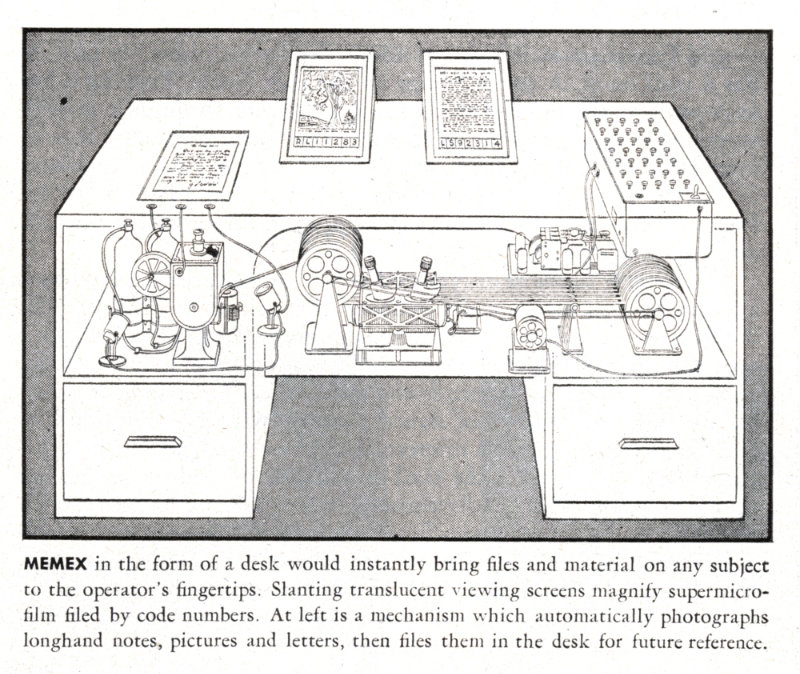James Nyce, Paul Kahn (eds.): From Memex to Hypertext: Vannevar Bush and the Mind’s Machine (1991)
Filed under book | Tags: · book, computing, history of computing, history of technology, hypertext, reading, technology, writing
“Vannevar Bush, the engineer who designed the world’s most powerful analog computer, envisioned the development of a new kind of computing machine he called Memex. For many computer and information scientists, Bush’s Memex has been the prototype for a machine to help people think.
This volume, which the editors have divided into sections on the creation, extension, and legacy of the Memex, combines seven essays by Bush with eleven others by others that set his ideas within a variety of contexts. The essays by Bush range chronologically from the early “The Inscrutable Thirties” (1933), “Memorandum Regarding Memex” (1941), and “As We May Think” (1945), to “Memex II” (1959), “Science Pauses” (1967), “Memex Revisited” (1967), and a passage from “Of Inventions and Inventors” (1970). Bush’s essays are surrounded by four chapters that place his changing plans for the Memex within his career and within information technology before digital computing.”
Contributors include Larry Owens, Colin Burke, Douglas C. Engelbart, Theodor H. Nelson, Linda C. Smith, Norman Meyrowitz, Tim Oren, Gregory Crane, and Randall H. Trigg.
Publisher Academic Press, San Diego and London, 1991
ISBN 0125232705, 9780125232708
367 pages
via Marcell Mars, in the Unlimited Edition
Memex animation (1995)
Review (George P. Landow, The Journal of Computing in Higher Education, 1992)
Review (Matthew Wall, College & Research Libraries, 1992)
Review (Liam Murray, ReCALL, 1993)
Espen J. Aarseth: Cybertext: Perspectives on Ergodic Literature (1997)
Filed under book | Tags: · computer games, electronic literature, ergodic literature, hypertext, literary theory, literature, text

Can computer games be great literature? Do the rapidly evolving and culturally expanding genres of digital literature mean that the narrative mode of discourse—novels, films, television series—is losing its dominant position in our culture? Is it necessary to define a new aesthetics of cyborg textuality?
In Cybertext, Espen Aarseth explores the aesthetics and textual dynamics of digital literature and its diverse genres, including hypertext fiction, computer games, computer-generated poetry and prose, and collaborative Internet texts such as MUDs. Instead of insisting on the uniqueness and newness of electronic writing and interactive fiction, however, Aarseth situates these literary forms within the tradition of “ergodic” literature—a term borrowed from physics to describe open, dynamic texts such as the I Ching or Apollinaire’s calligrams, with which the reader must perform specific actions to generate a literary sequence.
Constructing a theoretical model that describes how new electronic forms build on this tradition, Aarseth bridges the widely assumed divide between paper texts and electronic texts. He then uses the perspective of ergodic aesthetics to reexamine literary theories of narrative, semiotics, and rhetoric and to explore the implications of applying these theories to materials for which they were not intended.
Publisher John Hopkins University Press, 1997
ISBN 0801855799, 9780801855795
203 pages
review (Darren Tofts, Mediamatic)
wikipedia
publisher
google books
Lisa Gitelman: Scripts, Grooves, and Writing Machines: Representing Technology in the Edison Era (1999)
Filed under book | Tags: · history of technology, hypertext, kinetoscope, language, phonograph, reading, technology, typewriter, writing

This is a richly imaginative study of machines for writing and reading at the end of the nineteenth century in America. Its aim is to explore writing and reading as culturally contingent experiences, and at the same time to broaden our view of the relationship between technology and textuality.
At the book’s heart is the proposition that technologies of inscription are materialized theories of language. Whether they failed (like Thomas Edison’s “electric pen”) or succeeded (like typewriters), inscriptive technologies of the late nineteenth century were local, often competitive embodiments of the way people experienced writing and reading. Such a perspective cuts through the determinism of recent accounts while arguing for an interdisciplinary method for considering texts and textual production.
Starting with the cacophonous promotion of shorthand alphabets in postbellum America, the author investigates the assumptions—social, psychic, semiotic—that lie behind varying inscriptive practices. The “grooves” in the book’s title are the delicate lines recorded and played by phonographs, and readers will find in these pages a surprising and complex genealogy of the phonograph, along with new readings of the history of the typewriter and of the earliest silent films. Modern categories of authorship, representation, and readerly consumption emerge here amid the un- or sub-literary interests of patent attorneys, would-be inventors, and record producers. Modern subjectivities emerge both in ongoing social constructions of literacy and in the unruly and seemingly unrelated practices of American spiritualism, “Coon” songs, and Rube Goldberg-type romanticism.
Just as digital networks and hypertext have today made us more aware of printed books as knowledge structures, the development and dissemination of the phonograph and typewriter coincided with a transformed awareness of oral and inscribed communication. It was an awareness at once influential in the development of consumer culture, literary and artistic experiences of modernity, and the disciplinary definition of the “human” sciences, such as linguistics, anthropology, and psychology. Recorded sound, typescripts, silent films, and other inscriptive media are memory devices, and in today’s terms the author offers a critical theory of ROM and RAM for the century before computers.
Publisher Stanford University Press, 1999
ISBN 0804732701, 9780804732703
282 pages
Review (Daniel Gilfillan, RCCS, 2002)
Download (removed on 2013-11-12 upon request of the publisher)
Comment (0)

